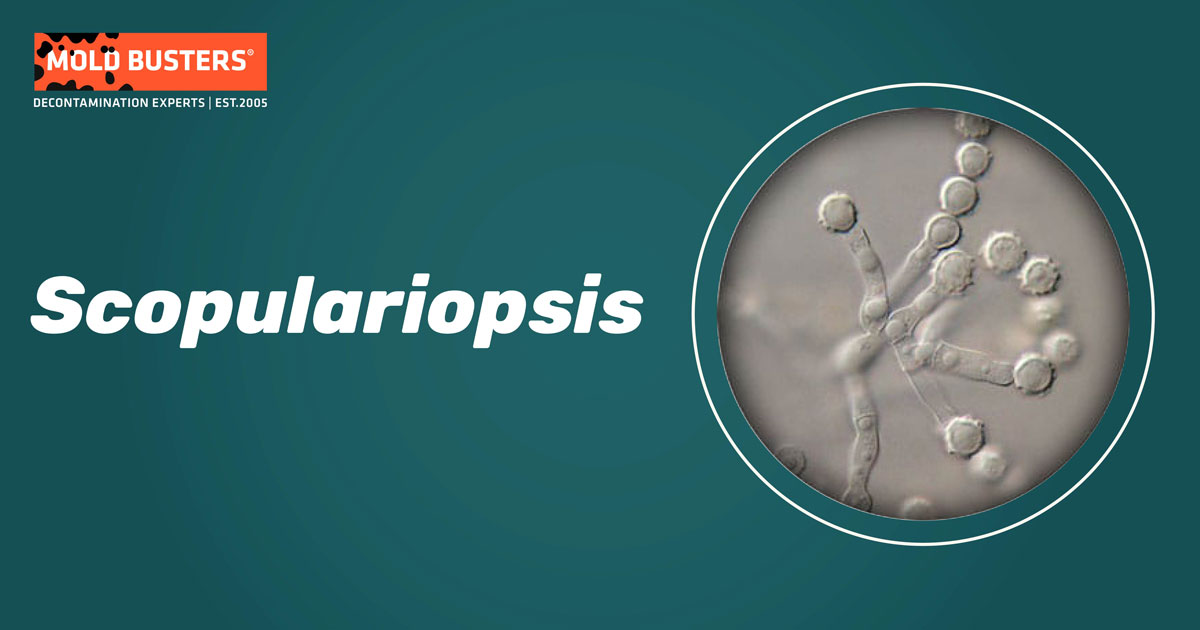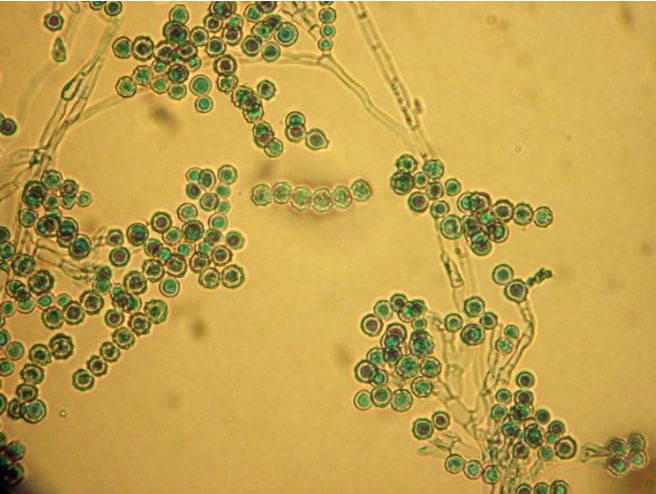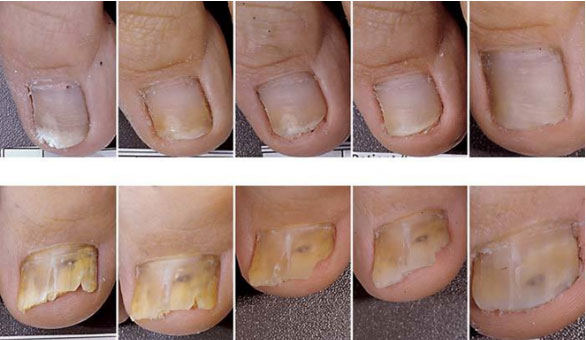We are exposed to mold every day. A mold-free environment is almost impossible to achieve even on that shiny metal surface in your kitchen. These tiny organisms are simply always present in our lives.
Molds expand by spreading hyphae that look like tiny hairs. [1] They reproduce via spores that are similar to ultra-small seeds. All of them cause biodegradation of natural materials, which is undesirable when food spoilage, property damage or health problems occur. Molds and other fungi also play a very significant role in biotechnology and food science, in the production of various types of food, beverages, drugs, antibiotics, and enzymes.

Molds require the right amount of moisture to grow, but spores can survive in very dry or cold conditions until the environment becomes moist enough for them to sprout. They thrive in many various types of conditions even when you do not see them.
What is Scopulariopsis?
The genus Scopulariopsis, discovered by Bainier (1907), is a genus of fibrous fungi belonging to the group Hiphomicetes. Almost all species of Scopulariopsis are anamorphs, which means that they reproduce only asexually. A small number of species of Scopulariopsis have teleomorphs that are typically known as fruiting bodies and are classified in the genus Microascus.
They are saprobic and pathogenic to animals and humans. [2] Saprobes are a group of fungi that act as decomposers, feeding on dead and decaying wood, leaves, and other organic matter. Decomposers are essential for the survival of the ecosystem. The Hyphomycetes family includes fibrous fungi that multiply by conidia and which are mainly formed in the air on conidiophores derived from the substrate. Colonies grow rapidly at 25° C, reaching 4.5––5.5 cm in one week. The colonies are initially white, but as they mature, they become puffy and powdery to granular in texture and develop a brownish colour.

The genus Scopulariopsis includes more than 30 species.
Scopulariopsis includes both hyaline molds (fungi that grow generally in filamentous form with uncoloured hyphae) and dematiaceous molds (darkly pigmented fungi whose teleomorphs are contained as part of the genus Microascus). They are usually isolated from soil, air, plant debris, paper, and a humid enclosed environment. [3-5] The most common species is Scopulariopsis brevicaulis. Other unpigmented species include Scopulariopsis candida, S. koningii, S. acremonium and S. flava. Dematiaceous species include S. cinerea (the anamorph form of Microascus cinereus), S. trigonospora (the anamorph form of Microascus trigonosporus), S. brumptii, S. chartarum, S. fusca and S. asperula.
All of these species are found in food, drywall, wallpaper, wood, dust, rotten wood, and various other plant and animal products.
A sexual form called Microascus brevicaulis has recently been identified. [6] Bartolomeo Gosio discovered that in humid conditions, this species produces significant amounts of trimethylarsine by biomethylation of inorganic pigments used in interior wallpaper, which is then released into the air. [7] Anamorphic and teleomorphic connections have already been established for many species. The sexual conditions of some species of Scopulariopsis are not yet known. [10]
Where can Scopulariopsis be found?
Indoors, Scopulariopsis can be found on wallpaper, drywall, wood and dust from mattresses. Scopulariopsisspecies are usually isolated from hospital floors, carpets, swimming pools, wooden food packaging, shoes, and ligneous pulp.
Scopulariopsis brevicaulis is by far the most common species found indoors. It has been found to grow on all kinds of decomposing organic matter, and it thrives on materials that contain high levels of protein, such as meat and cheese that ripen. Degrades cotton, textiles, and paper products and causes color deterioration. It is also understood as a human pathogen.
Health effects of Scopulariopsis
Scopulariopsis brevicaulis is widespread in nature and is usually isolated from the ground, especially in places where cellulose decomposes. Although often considered a pollutant, it can cause infection of various human systems including:
- skin and nails (onychomycosis),
- soft tissues
- lungs
- bone
- recipients of solid organs
- bone marrow grafting
Scopulariopsis species are common fungal contaminants both indoors and outdoors, but they also cause mycosis in humans, especially in immunocompromised patients.
They are among the fungi that cause onychomycosis, a fungal infection of the nails. Some symptoms may involve a white or yellow discoloration of the nail, thickening of the nail but also the separation of the nail from the toe.

Many species of Scopulariopsis can release arsenic gas from substrates that contain this element, which may be noticed as a garlic-like odour.
One of the most noticeable features of S. brevicaulis is its association with human death by the production of arsine gas from arsenic dyes found in wallpaper. The whole story was clarified by Frederick Challenger in 1945 when he identified gas as trimethylarsine. S. brevicaulis consumes the starch from the wallpaper. The fungus converts the arsenate found in the paper into trimethylarsine oxide. Finally, the oxide is reduced to trimethylarsine and a toxic gas is released. Although this phenomenon was initially associated only with S. brevicaulis, other molds found in the vicinity may also theoretically be able to release volatile arsenic compounds using the same mechanism. [9]
How to get rid of Scopulariopsis?
If you notice mold growth in your home or office, remove it as soon as possible. Most types of indoor mold can be dangerous to human health, especially for people who have lung problems, a weakened immune system, or those who often suffer from allergies.
But in severe cases, even in people with pre-existing health conditions, mold can lead to pneumonia and respiratory distress.
Genetic predisposition or a weakened immune system makes a person more susceptible to diseases caused by even small amounts of mold.. The most common symptoms of mold exposure are wheezing, shortness of breath, flu-like body aches, and unexplained fatigue.
You can find many commercial products that are effective for removing mold, but most contain harsh chemicals that can be as harmful as the mold itself.
When you suspect a mold contamination, you should get a professional mold test to see what species of mold you are dealing with and call a mold removal expert to help you remove them safely.

Did you know?
Basements in Canada are the most affected by the Penicillium/Aspergillus mold group?! Find out more exciting mold stats and facts inside our mold statistics page.
References
- Moore D, Robson GD, Trinci AP, ур. (2011). 21st Century Guidebook to Fungi . Cambridge University Press. ISBN 978-0521186957.
- Issakainen J, Heikkilä H, Vainio E, Koukila-Kähkölä P, Castren M, Liimatainen O, Ojanen T, Koskela M, Meurman O (2007). “Occurrence of Scopulariopsis and Scedosporium in nails and keratinous skin. A 5-year retrospective multi-center study”. Medical Mycology. 45 (3): 201–29. doi:10.1080/13693780601103080. PMID 17464841
- Barron GL, Cain RF, Gilman JC. 1961. The genus Microascus. Can. J. Botany 39:1609–1631 [Google Scholar]
- Morton FJ, Smith G. 1963. The genera Scopulariopsis Bainier, Microascus Zukal, and Doratomyces Corda. Mycol. Pap. 86:1–96 [Google Scholar]
- Samson RA, Houbraken J, Thrane U, Frisvad JC, Andersen B. (ed). 2010. Food and indoor fungi. CBS Laboratory Manual Series 2. CBS-KNAW Fungal Biodiversity Centre, Utrecht, The Netherlands [Google Scholar]
- Abbott, Sean P.; Sigler, L.; Currah, R. S.; Sigler, Lynne; Currah, R. S. (March 1998). “Microascus brevicaulis sp. nov., the Teleomorph of Scopulariopsis brevicaulis, Supports Placement of Scopulariopsis with the Microascaceae”. Mycologia. 90 (2): 297. doi:10.2307/3761306
- William R. Cullen, Ronald Bentley (2005). “The toxicity of trimethylarsine: an urban myth”. J. Environ. Monit. 7 (1): 11–15. doi:10.1039/b413752n. PMID 15693178
- De Hoog, G. S., J. Guarro, J. Gene, and M. J. Figueras. 2000. Atlas of Clinical Fungi, 2nd ed, vol. 1. Centraalbureau voor Schimmelcultures, Utrecht /Universitat Rovira I Virgili, Reus, Spain, 2000/1126pp.ISBN: 90-70351-43-9
- Neglia, J. P., D. D. Hurd, P. Ferrieri, and D. C. Snover. 1987. Invasive Scopulariopsis in the immunocompromised host. Am. J. Med. 83:1163-1166
- Sandoval-Denis M, Sutton DA, Fothergill AW, et al. Scopulariopsis, a poorly known opportunistic fungus: spectrum of species in clinical samples and in vitro responses to antifungal drugs. J Clin Microbiol. 2013;51:3937–43.

Get Special Gift: Industry-Standard Mold Removal Guidelines
Download the industry-standard guidelines that Mold Busters use in their own mold removal services, including news, tips and special offers:

Written by:
John Ward
Account Executive
Mold Busters
Fact checked by:
Michael Golubev
General Manager
Mold Busters
